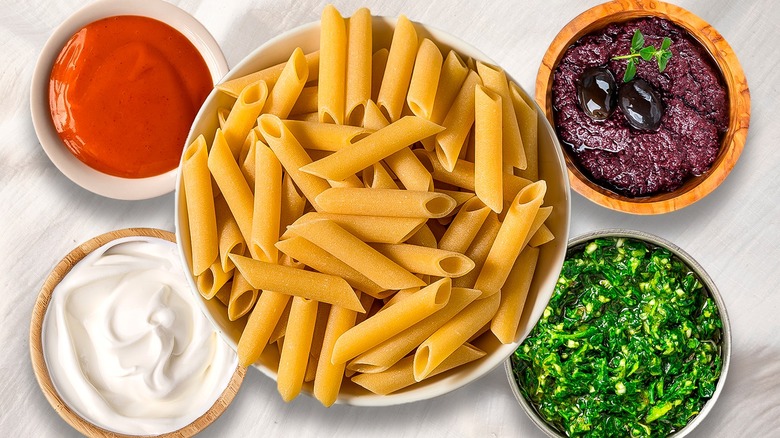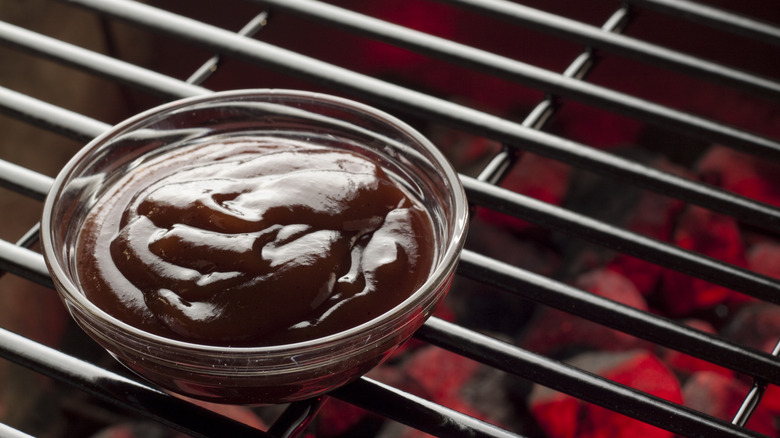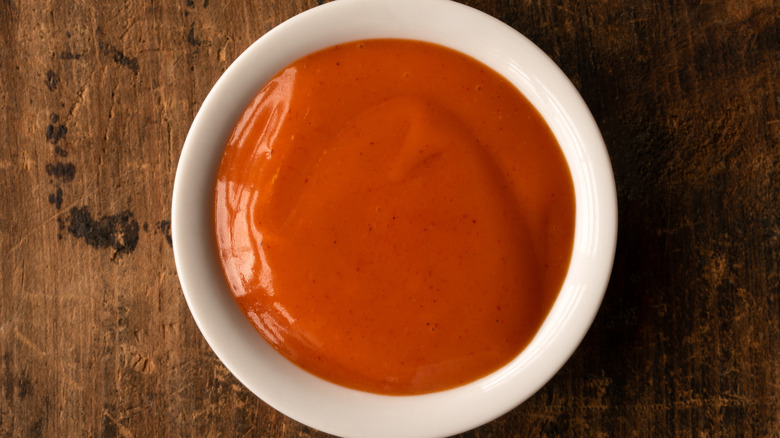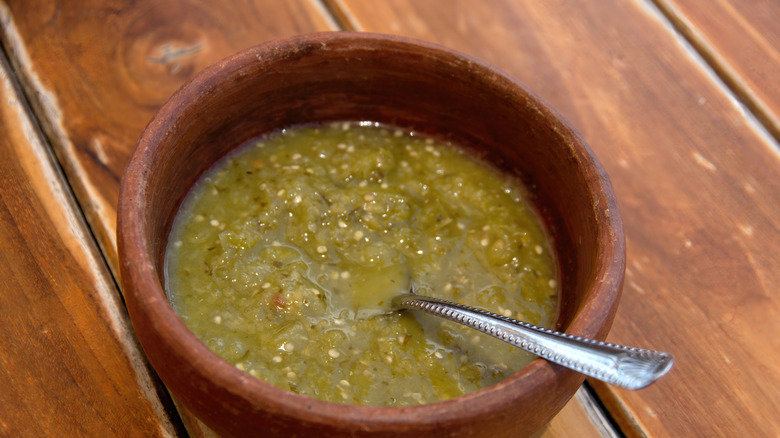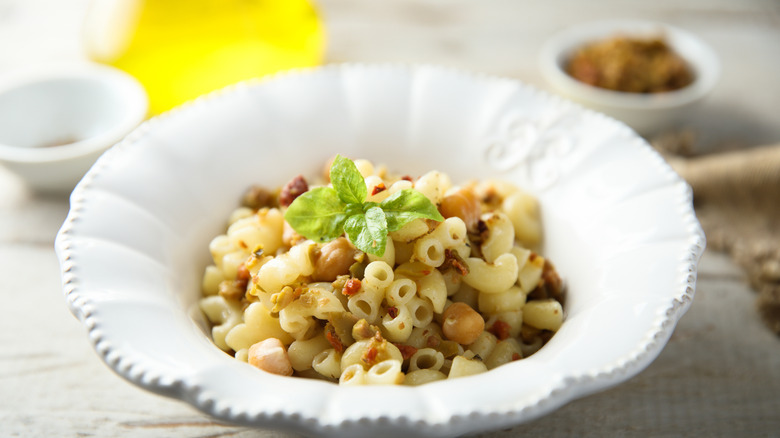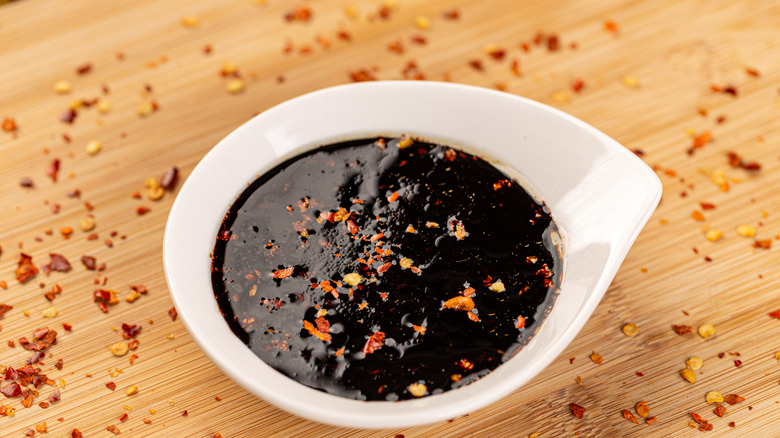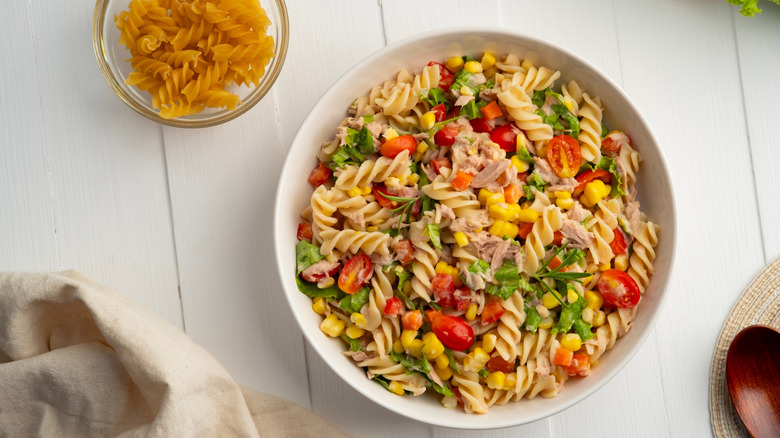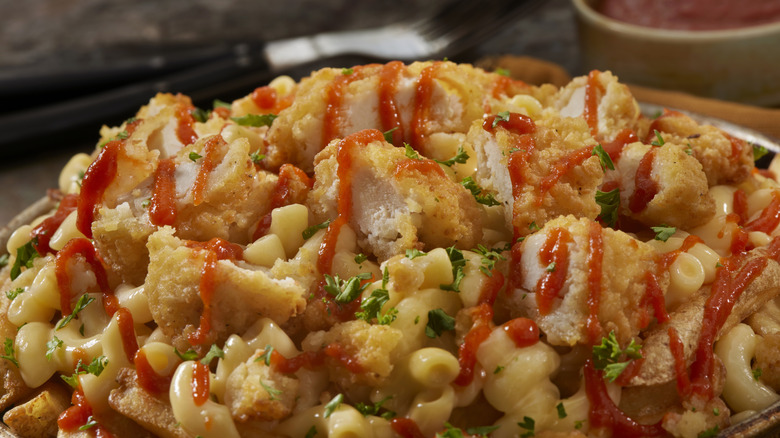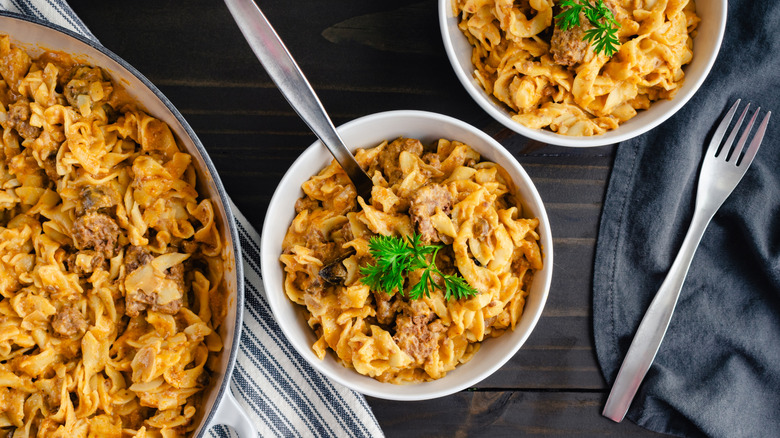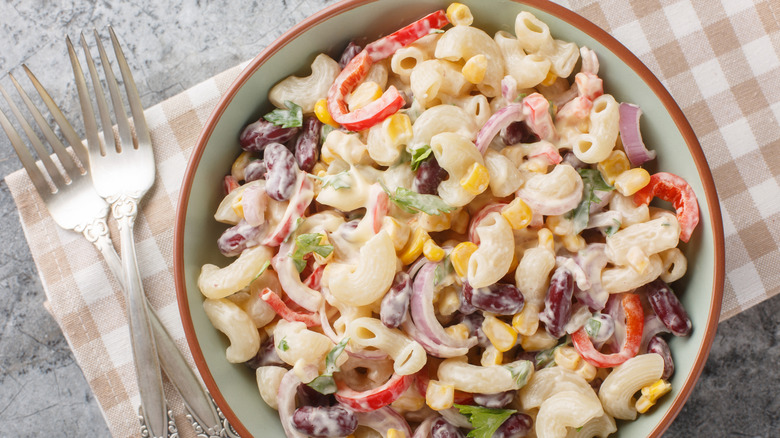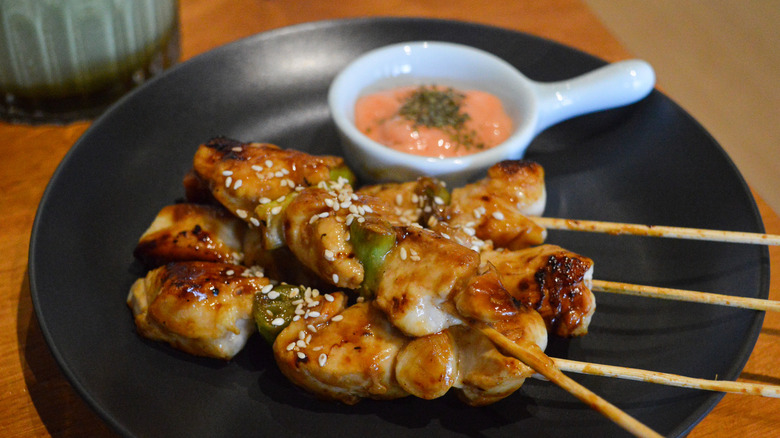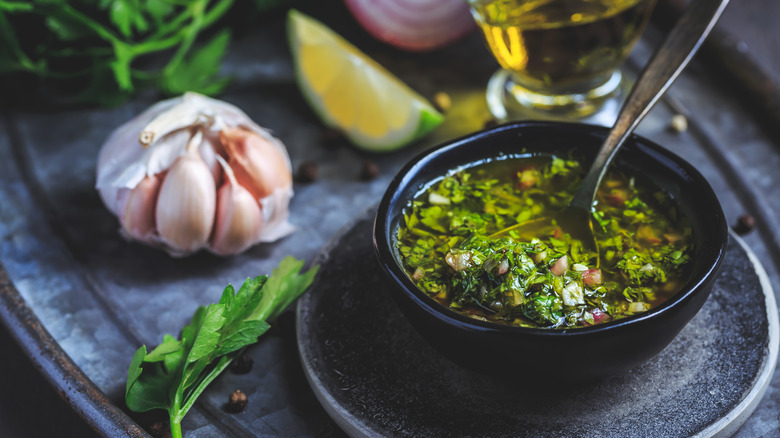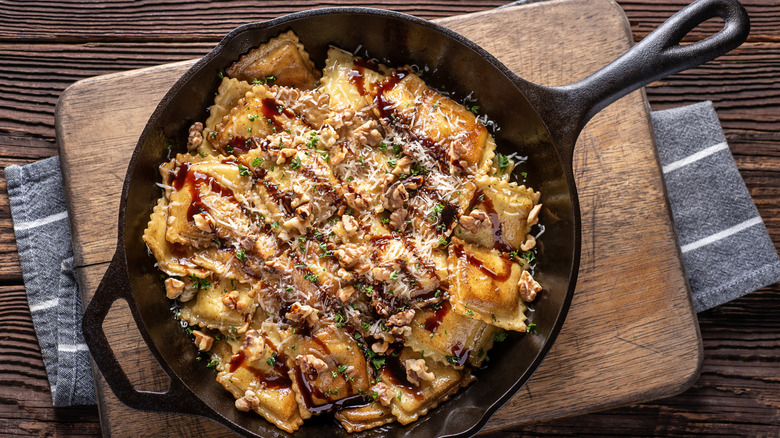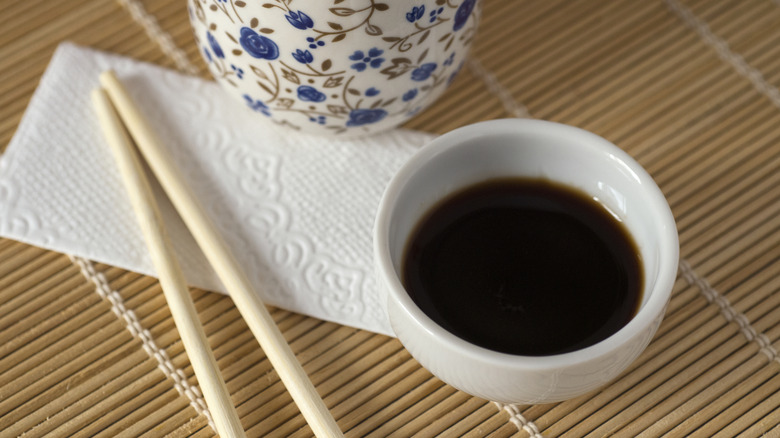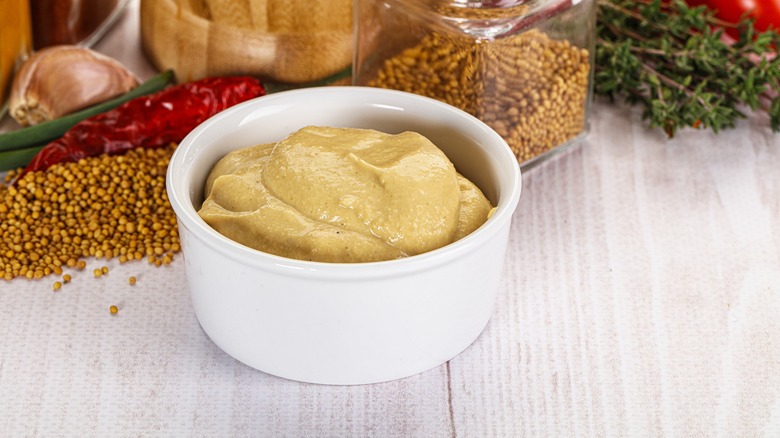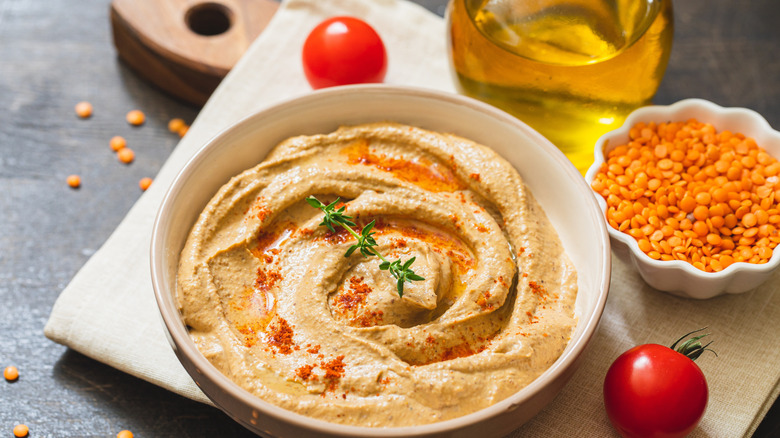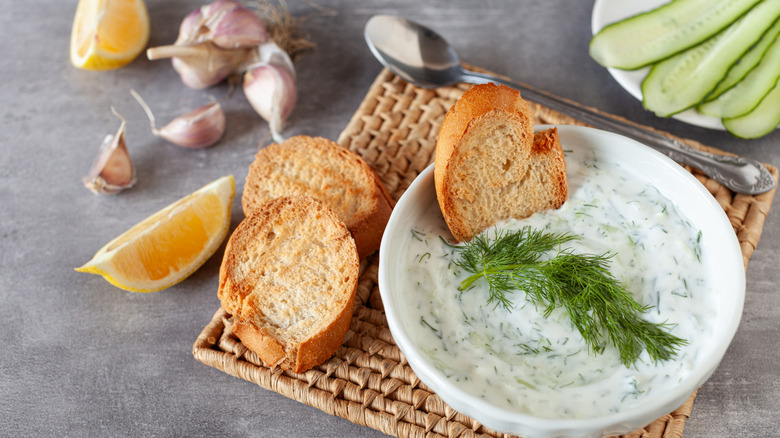16 Unexpected Condiments That You Should Really Try On Pasta
One trip to the grocery store will reveal the sheer diversity of condiments that are available across cuisines. While there's the typical American condiments, including ketchup, mustard, and mayonnaise, there's also a rich array of condiments and sauces from across the world that are perfect to elevate meals from "good" to "great." Though, you shouldn't just reserve condiments as a topping or dipping sauce for your burgers, french fries, or sandwiches. You can also repurpose these sauces for a bit more of an unconventional use: as a topping or ingredient in your pasta.
It might seem weird to add a squirt of barbecue sauce or mustard to your classic marinara, or to swap out your grandmother's pesto recipe for chimichurri. Nonetheless, these sauces are brimming with novel textures and flavors that will enhance a bowl of noodles, served warm or cold, and take your meal to the next level. Here are some of the condiments you should consider pairing with your pasta when you're looking to switch up your dinner routine.
Barbecue sauce
Swapping out your favorite marinara for a thick glob of barbecue sauce? Blasphemy.
While it might seem a bit odd that this thick, slightly sweet sauce could ever square up to your grandmother's treasured Sunday marinara, it might be a little less strange when you break barbecue sauce down into its parts. You have something slightly sweet, something slightly smoky, and something that's slightly umami. A balanced tomato sauce has all of these things, too — though it may not entirely deliver on the spice front.
You can select a barbecue sauce that has a similar flavor profile to what you're looking to achieve with your pasta. For example, you may want to try adding a tasty, hickory-smoked barbecue sauce to a pasta dish made with apples or bacon, since the flavors will all meld together well. Or, you could try pairing the most logical ingredient with this pasta dish: meat. Thinly shredded pork or chicken, coated in barbecue sauce, would add a hefty dose of protein to your otherwise carby meal and also infuse it with that succulent meaty flavor.
Buffalo sauce
Buffalo sauce has a lighter flavor than barbecue sauce and one noticeable difference: It does not skimp on the heat. The balance of tanginess and heat makes this wing sauce an excellent pairing for pasta — especially when decadent cheese is involved.
Buffalo mac and cheese is a great way for folks to get warmed up to the idea of pairing Buffalo sauce with pasta. This spicy sauce belongs in mac and cheese because it helps cut through that richness and makes for a well-rounded, savory dish. Once you've found a Buffalo sauce that you love, try adding just a little bit to your favorite marinara or red sauce recipe. Frank's Red Hot, which has a solid balance of vinegar and singe-your-tongue heat, can be cooked down into your marinara sauce. The cooking process will muddle some of that heat — but you should expect a little more warmth than your standard, status-quo red sauce.
Salsa verde
A couple of words come to mind when we think of salsa verde: bright, light, and elevating. While many condiments can add heaviness to a meal, salsa verde will make it taste much lighter — almost effervescent.
Pasta, an already heavy carb, craves the lightness and brightness from something like salsa verde. However, as with any condiment, you have to be really, really careful about how you use it. It has a very fragrant profile, so adding it to a tomato sauce would only make the acidic and flavorful components compete with one another. If you want to add it to a hot pasta dish, we would recommend sticking with a béchamel or something made with a thick, creamy, rich base. You'll also want to add a salsa verde that you like the taste of, since it will be very reflective in the final flavor of the dish.
Salsa verde pairs well with chicken, which is a relatively bland protein, because it will allow the flavor of the condiment to shine. You could also add a little bit of this salsa to your cold pasta salad as a dressing to give it a little bit of life; it pairs well with chopped tomatoes, cilantro, or fire-roasted corn.
Tapenade
Say what you will about the briny, earthy flavor of olives. Because when it's whipped into a tapenade and schmeared on a crusty slice of bread, it's nothing short of unbeatable.
It's time to start using that tapenade for more than just your charcuterie board. The subtle briny flavor of the olives is an excellent match for bland pasta. Tapenade, when used solo, can spruce up bowl of noodles, but it's even better when it's paired with some bright, acidic, and subtly sweet additions that can help balance out the salty flavor of both the olives and the capers. For example, some halved cherry tomatoes, freshly chopped basil, and a drizzle of olive oil can add some extra depth to a rich pasta dinner.
You'll want to ensure that your tapenade is thick enough for your recipe. Toss in some of the reserved pasta water to help thicken up the sauce and ensure that it sticks to the noodles.
Teriyaki sauce
Teriyaki is one of those sauces that we all have shoved somewhere in the back corner of our pantry. It's relegated to monthly clean-outs when we say, "Oh yeah, I forgot I bought this stuff!" But really, teriyaki sauce is a great complement to noodles — especially when they're served cold. Grab a bottle of store-bought teriyaki sauce and toss it with chilled spaghetti noodles to make a play on a soba noodle salad. The sweet flavor of the mirin and the sweetener will add a unique flavor profile to your pasta, while the salty soy sauce will offer a more typical noodle salad flavor.
Teriyaki sauce works well with other Asian-inspired ingredients — especially those that balance umami and salty flavors. You may try adding some sauteed mushrooms, chopped green onions, water chestnuts, and broccoli into your salad. Or, try a play on a slaw by tossing a store-bought coleslaw mix (all the veggies are pre-chopped, which makes your life a whole lot easier) with noodles and the sauce.
Italian dressing
If there is one condiment on this list that you're already familiar with putting on pasta, it's probably Italian dressing. Italian dressing is the basis for a tasty pasta salad recipe. The acidity of the dressing, compounded by the seasoning and herbs mixed into it, offers a bright and elevating flavor. Perhaps the best part about putting Italian dressing on your pasta salad, though, is that goes with nearly every type of ingredient you choose to add to your salad. For one, you can try a veggie antipasti Italian pasta salad with kalamata olives, tomatoes, mozzarella, and hearts of palm. Or, try a tortellini Greek salad, which swaps conventional pasta noodles for cheese-filled tortellini.
While Italian dressing is often thought to be a topping for cold pasta, you could also add it to warmed pasta, too. Toss it with veggies, noodles, and a little bit of Parmesan for an easy weeknight meal.
Hot sauce
Hot sauce fiends of the world: This one is for you. Unlike many of the other condiments on this list, hot sauce is one that you'll want to add to your pasta dish incrementally and pair with milder-tasting ingredients. For one, hot sauce goes well with cheesy pasta dishes because the dairy product helps subdue some of the piquant flavors of the sauce and makes each bite a little more approachable.
You should always try to find a hot sauce that you enjoy eating and then add it to your pasta. There are tons of grocery store hot sauces to choose from, including ones made with different peppers, spice levels, and acidity. Sriracha is a crowd-pleaser and could add a bit of heat to your macaroni and cheese. Or, try Crystal hot sauce on a pasta dish made with Cajun-inspired ingredients, like andouille sausage.
Sour cream
Sour cream is more useful of an ingredient than you may think when it comes to pasta. As you can expect, sour cream's thick consistency and fatty mouthfeel make it a shoo-in for decadent and creamy pasta recipes. For one, you could add a scoop of sour cream to your beef stroganoff recipe to make it extra creamy and slightly tangy. You'll want to add it in toward the end of the cooking process, along with a little mustard, to help thicken up the sauce and cause it to stick to the noodles a bit better.
Sour cream is also the tangy ingredient you need to add to your pasta sauce. It can replace other thickeners and dairy-based additions, like heavy cream. Like with beef stroganoff, you'll want to avoid adding your sour cream to the pot too prematurely, as cooking it too much may cause it to curdle and split. Moreover, since this spread is so thick, a little goes a long way.
Ranch
Ranch is a condiment that has a cult-like following. While plenty of people use it for dipping hot wings into or serving alongside wavy potato chips, it's equally as delicious when added to a bowlful of pasta. Ranch has a slight buttermilk flavor, which makes it super rich, along with a subtle hint of herbs to counteract its heaviness. It's a great swap for Italian dressing in a cold pasta salad because the ranch will offer a creamy mouthfeel and herby flavor.
If you're a big fan of chicken bacon ranch quesadillas, you should totally try that riff on a pasta salad. Succulent chunks of chicken, fatty bacon, and plenty of ranch dressing will really change the way you think about this barbecue side dish as a whole. Ranch is highly versatile with veggie pairings, too; anything that you see served with the dip on a crudité plate would work. Try chopped carrots, broccoli, or celery to start.
Peanut sauce
Peanut sauce is one of the most underrated dipping condiments out there. It's an excellent pairing for chicken or tofu satay, since the nutty, slightly umami flavor of the sweet-salty peanut sauce meshes well with the protein. If you're looking for an Asian-inspired spin on pasta night, reach for a jar of it (or make one yourself).
For a satay-style peanut sauce, you'll need to combine your favorite creamy peanut butter with lime juice, soy sauce, honey, and garlic powder. Or, you can try your hand at a spicy peanut sauce with sauteed garlic, ginger, chili sauce, and hoisin.
We'd recommend using a thin, spindly pasta, like spaghetti or angel hair, to get the best ratio of peanut sauce to pasta. Toss the warmed noodles with some chopped vegetables, like cabbage, snow peas, and cooked broccoli, or add a dusting of Parmesan on top for an extra umami kick. This makes for an easy side dish or lunch.
Chimichurri
We like to think of chimichurri as being pesto's fun cousin. This South American dipping sauce is typically added to grilled meats and is often served chunky. Each bite is filled with the herby pop of cilantro or parsley, garlic, chiles, vinegar, and olive oil. Although it clearly has a lot going on, it has a ton of potential when it comes to pastas — mainly those dishes that feature a charred protein.
If you're trying to master the basic chimichurri recipe, start with a simple pasta recipe. Whip up the sauce in a food processor before tossing in angel hair pasta; it's light enough to balance out the herbs and seasonings in the condiment. From there, you can experiment with different proteins, like charred steak, chicken breast, or shrimp. Since chimichurri has a rather bold flavor, it's difficult to pair it with different vegetables, as adding too many of them may distract from the flavors already present.
Balsamic vinegar
Balsamic vinegar is less of a stand-alone sauce and more of a complement to other bases. Its flavor is molasses and almost prune-like, which explains why it's such a great complement to rich and heavy sauces. When you're first exploring this ingredient, try using it to give cream-based pasta sauce a bold new dimension. To prevent curdling, you'll need to reduce the balsamic vinegar in a pan before you add in the rest of your ingredients.
Balsamic vinegar also has a place in cold pasta salads, too. You can try making a twist on a caprese pasta salad by swapping out the traditional pasta shape for a cheese-filled tortellini and pairing it with balsamic vinegar (or a reduction, depending on the texture you're craving), chopped tomatoes, basil, extra virgin olive oil, and a quality sea salt. This pasta salad, which is appealing to almost all eaters, is a great choice to include in your summer barbecue lineup.
Soy sauce
Soy sauce and pasta? Right off the bat, this may not seem like a pairing that would work well. But, soy sauce can deliver a concentrated hit of umami and saltiness that will surely elevate your dish — especially when it's paired with other Asian-inspired ingredients. Try a miso mushroom pasta recipe, which is seasoned with both white miso paste and soy sauce, to switch up your regular dinner routine.
You can also add soy sauce to your plain marinara sauce to help balance out the flavors a bit more. The salty flavor from the soy sauce will help counteract some of the acidity from the tomatoes or sweetness from additions like sugar. You can use soy sauce as a flavor enhancer in meat-based pasta sauces, like Bolognese and ragù, too. The salty condiment will draw attention to the umami flavor of the meat. Regardless of where you're planning to use it, just be sure to use a small amount of it; too much soy sauce can shift your recipe off balance.
Dijon mustard
Dijon mustard is one ingredient that all chefs and home cooks should be familiar with. This French mustard can be found in a broad swath of dishes; the sinus-clearing, spicy condiment is a beloved component of a variety of sauces, and many folks add it to salad dressings. You, too, can harness the flavor and power of Dijon by adding it to your next pasta sauce recipe.
Dijon is excellent to add to warm pasta dishes, as the flavor mellows out when combined with the soft noodles and other ingredients. Anyone who has worked with this ingredient knows that the flavor can be dominant and, frankly, somewhat overbearing at times. So, you'll want to pair it with bland proteins, like chicken, or something that can hold up to the flavor of the condiment, like a well-seasoned sausage. You could also try adding a couple spoonfuls to your mac and cheese recipe to heighten the flavor of the dish and complement the creamy, cheesy sauce.
Hummus
Hummus might seem like one selection that's a little out of left field. After all, this creamy, bean-based dip is often reserved for a plate of baby carrots and pita bread — what does that have anything to do with pasta?
Hummus is actually the key to decadent pasta with minimal effort. All you need to do is combine some of the reserved, starchy pasta water with the hummus, give it a good stir, and toss your pasta in it. In a matter of minutes, you can have a two- (technically three) ingredient pasta dish on your hands — with all the proteins and carbs you need for it to be satisfying. That being said, you can always add some extra fiber with some chopped tomatoes or red onions or swap out your standard plain hummus for a roasted red pepper, garlic, or (if you like all things colorful) beet-infused rendition.
Tzatziki
Tzatziki, like hummus, is often reserved for dipping. But, it's actually a much more versatile condiment than you might think. Besides adorning your burgers with it or using it as a sandwich spread, you could also use this Greek yogurt-based dip as a substitute for mayonnaise in your cold pasta salad. It's great for folks who can't stand the texture and eggy flavor of mayonnaise. Plus, the dill in the tzatziki will elevate your chilled pasta and give it a refreshing twist.
Tzatziki already includes chopped cucumbers, so you can build out your loaded pasta salad from there. Some chopped tomatoes or red onion would add a ton of extra texture to this otherwise one-note side dish. We wouldn't recommend adding tzatziki to a warm bowl of pasta, though, as you don't want the yogurt to split or lose any of its thick, unctuous consistency.
